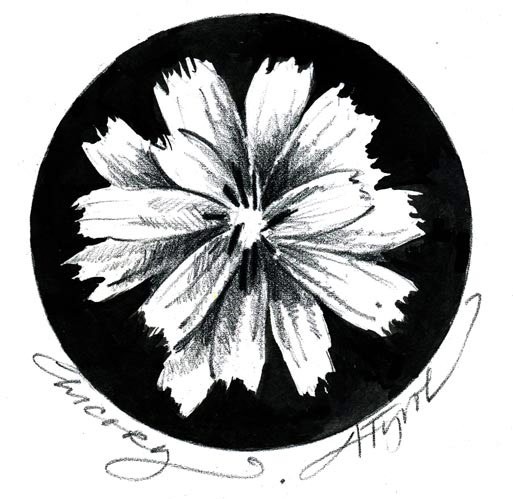
I remember being a kid in the backseat of my mom’s giant blue station wagon, lost in observation as the world rolled by. Growing up on the fringe of the urban world of Hartford, Connecticut, I distinctly recall the blue flowers of common chicory along the exit ramps as we left the highway and rolled to a stop. They were tall, growing out of what looked like sand, with occasional bits of litter at their stems. They were “city flowers,” I thought, not growing in a sun-soaked garden, nor taking root in a lush New England forest, but, instead, flowering profusely among the exhaust fumes and trash of the road.
Truth is, many wildflowers thrive in such waste places – a term you’ll see frequently in any wildflower guide. Common chicory, Cichorium intybus, needs bare mineral soil and lots of light, explained Arthur Haines, research botanist at the New England Wild Flower Society.
“The species that grow in waste areas, roadsides, or fields need open habitat, bare mineral soil that is exposed, and represent the early stage of development or succession on that site,” he said. “They’re species that arrive really early to disturbed areas and need bright open sun. Six inches of leaf litter and they just won’t germinate.” Haines said such waste areas may be created from a wildfire, a flood, or if people bulldoze the site.
Chicory is a composite flower, meaning that what we might consider the flower is actually made of a bunch of flowers.
“Each petal you see on chicory is actually a flower, a ray flower,” Haines explained. “In the center are tubular (or disk) flowers.” Composite flowers can have either or both types of flowers. A daisy is another example of a flower with both ray and disk flowers. Hawkweed, on the other hand, only has ray flowers.
Haines said ray flowers (petals) are grouped together to aid in insect attraction. “Insects are trained to pollinate flowers, so you better darn well look like a flower. If your flowers are really tiny, you put a bunch together.”
Introduced from Europe, chicory is naturalized in the United States. “It doesn’t need us to pollinate it or care for it like a garden plant. Although a lot of our garden plants escape [into the wild] for a while, they won’t exist for long. You wouldn’t see a bunch of sugar snap peas growing along the highway,” Haines said.
In chicory’s native Europe, the dried and ground roots have been enjoyed as a beverage for a long time. The drink has an earthy flavor, Haines said, a bit on the bitter side. In the United States, chicory gained popularity as a coffee substitute and additive during World War II, when shipments of coffee beans were interrupted. “Corn, roasted peas, and rye were also really common substitutes or ingredients added to make coffee supplies last longer,” Haines said.
Today, you can still find ground chicory for sale alongside coffee in the grocery store, and a quick Internet search will give you numerous web pages depicting the harvest and processing of chicory for do-it-yourselfers. Some sites tout the medicinal benefits of chicory, which Haines said can’t be ignored.
“Chicory is now grown for inulin,” he said, “a pre-biotic that is beneficial to pro-biotics, which aid intestinal flora.” Inulin has also been shown “to aid in the absorption of minerals like calcium and magnesium.”
According to National Audubon Society’s Field Guide to Wildflowers, millions of pounds are harvested for these uses each year. But I like chicory best because it’s just so darn pretty. The sky-blue flowers of this herbaceous perennial are now in bloom, but each flower head only lasts one day. I had to ask Haines, “Is it OK to pick them?”
“You bet,” he responded. “Right now our culture has a mantra: take only photographs, leave only footsteps, never leave trails, don’t collect anything. All of this has its place, but it’s essentially done to keep people from interacting with wild plants. We feel like anything we do to these plants ends up harming them, which is often completely untrue.”
If we were to leave chicory alone, there would be an accumulation of fallen leaves and stems, which would eventually change the soil. “In 10 to 20 years there will be a forest on that site. If we dig some chicory roots periodically, we’re re-disturbing the site, we’re eradicating some of its competitors through accidental weeding, and we’re re-seeding it.”
Human activity, Haines said, benefits chicory over the long term. Feel free to pick and enjoy.


Discussion *